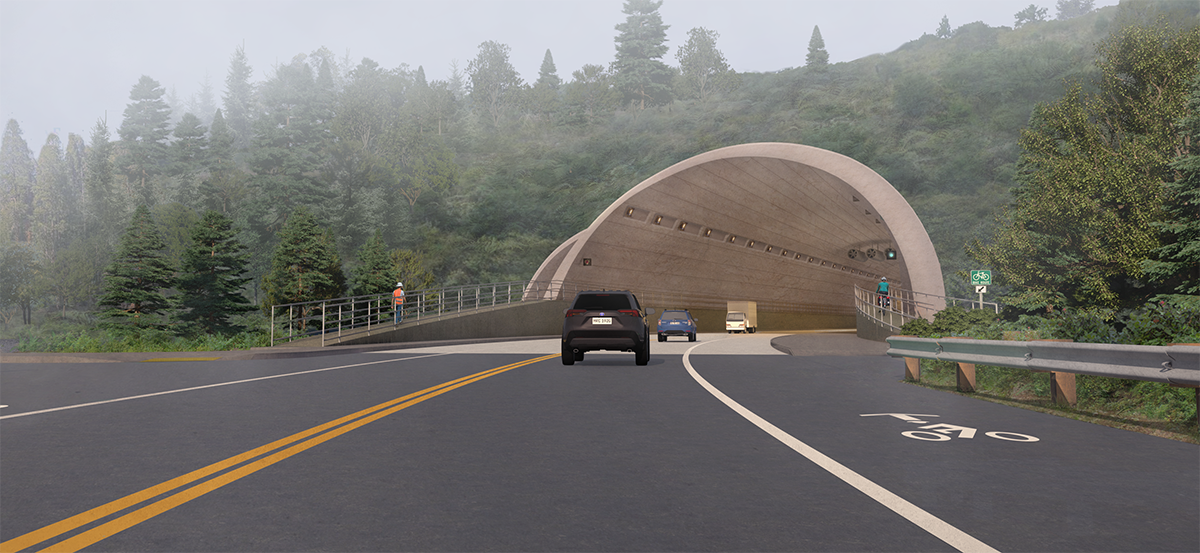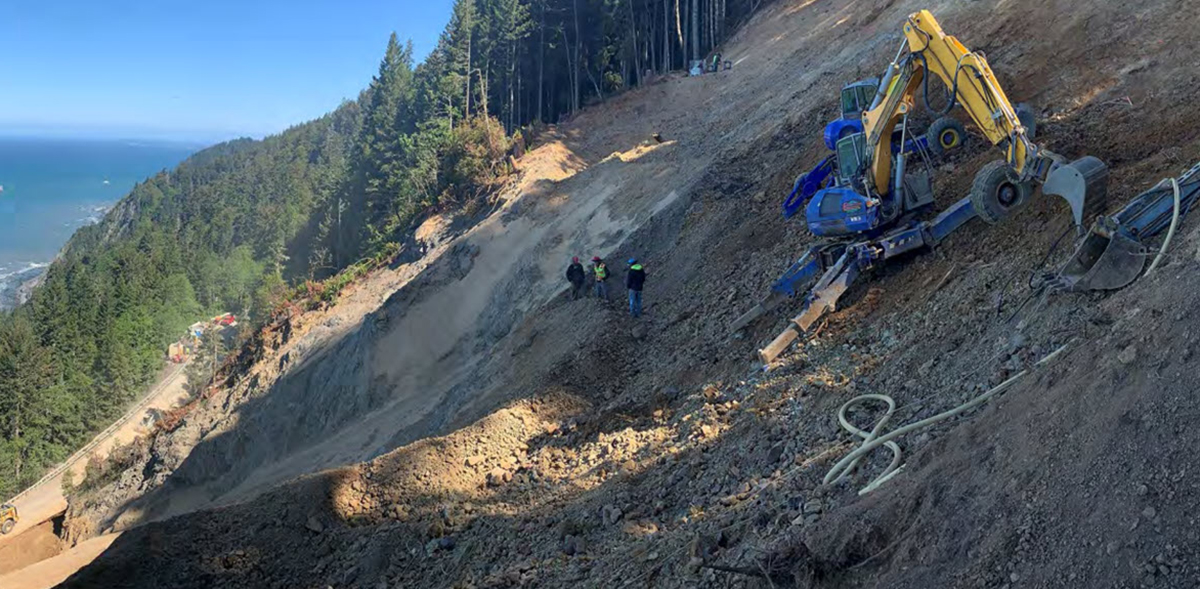 Caltrans
Caltrans In the shadows of California redwoods, a stretch of highway called the Last Chance Grade has been living up to its name.
For decades, the 3-mile stretch of Highway 101 experienced repeated, devastating destruction. Landslides churn down mountain slopes, uprooting the roadway and necessitating a solution.
Further reading:
- San Francisco’s hidden engineering feat: How a tunnel helped rebuild a city
- California's subway tunnels exemplify seismically safe infrastructure
- In landslide-prone areas, earthquake effects can extend for years
“Since 1995, more than $125 million has been invested in efforts to keep Last Chance Grade operational, with nearly $100 million spent since 2015, but nature has consistently pushed back,” said Lianna Winkler-Prins, project manager for the California Department of Transportation’s Last Chance Grade Project.
Even with these investments, the roadway shows no sign of stabilizing and will require more fixes in the future.
Along with the financial toll of these repeated repairs, each event also strands communities in Del Norte County, isolating residents from the rest of the state, limiting access to critical school and medical services, and causing significant economic impacts.
Caltrans and a group of partner organizations and agencies (called Partners) have been collaborating to consider alternative infrastructure to avoid these commonplace damages and repairs. These Partners have been working together to not only develop alternative routes for the troublesome stretch of highway but also to assess the impacts of each proposal, including biological, archaeological, cultural, and geological factors.
Ultimately, a tunnel was chosen as the best solution for avoiding continuous repairs. The 1.1-mile proposed tunnel will be the longest in Caltrans history and will require clever engineering through the complicated terrain. The Last Chance Grade tunnel may still face some uphill climbs, including funding a multibillion-dollar fix in an era of tightening budgets.
A dicey stretch of highway
The Last Chance Grade is between Eureka and Crescent City in coastal Northern California – coincidentally a perfect location for natural hazard mayhem.
“Perched on steep, forested cliffs overlooking the Pacific Ocean, the site is geologically active and highly prone to landslides,” Winkler-Prins said.
The aptly named Broken Formation – a highly fractured and jointed rock mass that offers little natural cohesion – underlies the Last Chance Grade. Pair this with the ever-active Cascadia Subduction Zone and you get a recipe for slope instability.
Over the years, Winkler-Prins noted, Caltrans has implemented a range of stabilization measures for Last Chance Grade, including soil nail walls, pile-ground anchor-timber lagging retaining structures, and cable net drapery systems, designed to reinforce the highway against landslides and rockfalls. While these efforts helped slow the rate of slope movement and protected the roadway from immediate hazards, the efforts did not address the overall geological instability in the region.
With unstable rock and rumbling earthquakes, the area is perpetually sliding.
“The steep terrain, combined with heavy rainfall, seismic activity, and the dynamic geology of the Cascadia Subduction Zone, means that even the most advanced engineering solutions have only bought time, not permanence,” Winkler-Prins explained. “Despite ongoing maintenance and emergency repairs, the route remains vulnerable to sudden closures and long-term disruptions.”
Rerouting over or under?
Considering Last Chance Grade’s location within a protected national park and a UNESCO World Heritage Site, changing the footprint of a major stretch of highway was a fraught endeavor. Starting in 2015, Caltrans and its Partners from the California Department of Parks and Recreation, the National Park Service, the Yurok Tribe, the Tolowa Dee-ni’ Nation, the Pulikla Tribe of Yurok People, the Elk Valley Rancheria, and the Green Diamond Resource Co. began a feasibility study to find alternatives to the current Last Chance Grade.
More than 15 alternatives were originally considered, and each option was evaluated on geotechnical, environmental, cultural, engineering, and planning considerations and impacts. These options included rerouting of the highway and bridges overland, as well as digging underground tunnels to avoid the most unstable rock formations. The alternative ideas that created greater impacts without accompanying value were eliminated.
In the final round, three alternatives were considered: maintaining the existing alignment with no planned new construction, an underground tunnel that would avoid most of the landslide complex, or a slight realignment of the highway with a subsurface drainage system added.

“After extensive analysis, the tunnel alternative emerged as the most balanced and forward-looking solution,” Winkler-Prins said. “It bypasses the most geologically unstable section entirely, minimizes surface disturbance in the protected Redwood National and State Parks, and offers the best chance of delivering a safe, resilient, and sustainable route for generations to come.”
“After many generations of Del Norte County citizens traversing this fabled, continuously failing section of our state highway system, we have reached the conclusion to construct a tunnel with broad agreement among regional stakeholders,” said Del Norte County Supervisor Chris Howard in a statement. “Del Norte County is grateful to our community, tribal, environmental, and agency partners that have dedicated many years to finding a path forward.”
Construction and funding
The engineering of a tunnel in a geologically sensitive area like Last Chance Grade is complex. Each engineering decision must be made with care to avoid increasing instability.
For example, Winkler-Prins explained that for the proposed tunnel alignment, the team will enter south of the most unstable slope and exit to the north, effectively sidestepping the most unstable areas.
She added that the construction team expects to use the Sequential Excavation Method, “a well-established tunneling technique particularly suited for variable and unstable ground conditions like those found at the site. SEM involves carefully staged excavation with continuous monitoring, supported by an initial lining of rock bolts and shotcrete to stabilize the tunnel as it advances.
“Once the excavation is complete, a waterproof membrane will be installed, followed by a cast-in-place final concrete lining to ensure long-term durability and safety.”
The proposed tunnel is estimated to cost between $1.75 billion and $3.25 billion, depending on final design choices, geotechnical conditions, and inflation factors. Funding is not yet secured, but Winkler-Prins said it would likely be supported through a combination of federal, state, and local sources.
She notes that given the current fiscal environment, securing federal funding is “competitive,” but she said there are clear benefits to the Last Chance Grade tunnel project.
“By eliminating a long-standing hazard on U.S. Highway 101, the tunnel would improve roadway safety, reduce costly emergency repairs, and ensure dependable access for rural and tribal communities,” Winkler-Prins said. “These outcomes align with the administration’s emphasis on streamlining project delivery, enhancing national competitiveness, and investing in infrastructure that supports economic growth.”



